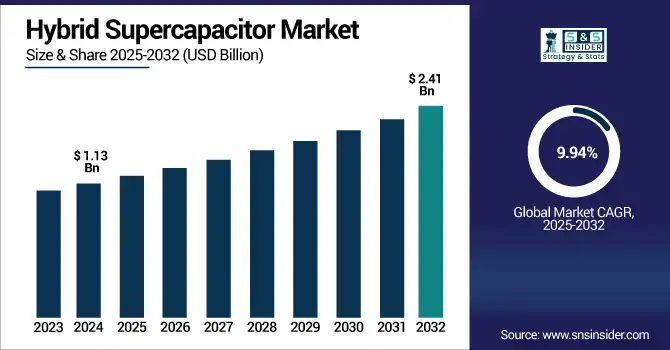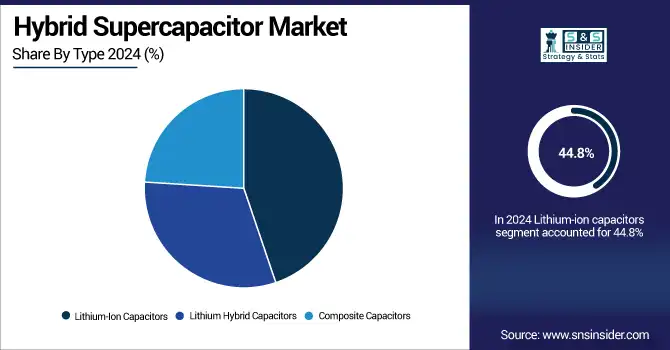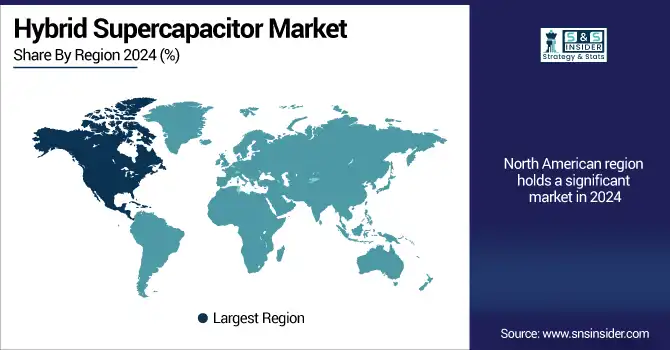Hybrid Supercapacitor Market Size Insights:
The Hybrid Supercapacitor Market Size was valued at USD 1.13 billion in 2024 and is expected to reach USD 2.41 billion by 2032 and grow at a CAGR of 9.94% over the forecast period of 2025-2032. The global market is segmented by type, component, application, and energy density, including regional performance detailed analysis. A fast-growing ecosystem, driven by increasing demand for fast-charging, high-energy-density solutions across automotive, industrial, and renewable sectors. Offering durability against environmental fluctuations, these supercapacitors are considered the best choice for high-efficiency systems. Hybrid Supercapacitor Market analysis reveals evolving trends in energy resilience, as rapid technological advancements and adoption in mission-critical applications are driving the market toward global adoption.

To Get more information on Hybrid-Supercapacitor-Market - Request Free Sample Report
For instance, compared to lithium-ion batteries, hybrid supercapacitors show a 60% lower risk of thermal runaway under fault conditions.
The U.S. Hybrid Supercapacitor Market size was USD 0.23 billion in 2024 and is expected to reach USD 0.49 billion by 2032, growing at a CAGR of 9.69% over the forecast period of 2025–2032.
The U.S. market is stimulated by the rapid adoption of electric vehicles, increased grid modernization activities, and the growing need for energy storage for both defense and aerospace applications. Bolstered by robust technological framework and conducive policies for sustainable energy at large, the nation is emerging as a frontrunner of hybrid supercapacitor innovations. All these factors combined enable the U.S. to be at the heart of the development of the next generation of high-performance, thermally stable energy storage technologies.
For instance, hybrid supercapacitors show a 70% lower failure rate in extreme environments compared to conventional battery alternatives.
Hybrid Supercapacitor Market Dynamics:
Key Drivers:
-
Increasing Demand for Efficient Power Storage in Electric Vehicles and Consumer Electronics Drive Market Expansion
Hybrid supercapacitors are characterized by their high-power density and rapid charge/discharge property, which leads to their significant applications in electric vehicles and portable electronics in the continuous advancement. They offer bursting power and long lifecycle advantages, filling the gaps of battery limitations. Automotive manufacturers and tech giants are warming up to them for improved efficiency, particularly in applications, such as regenerative braking and energy backup systems. The surge in proliferation of EVs and portable devices is directly contributing to the demand for hybrid supercapacitors worldwide, as they represent novel energy storage systems that are highly compact and efficient.
For instance, in regenerative braking systems, hybrid supercapacitors can recover and reuse up to 30% of braking energy.
Restraints:
-
High Initial Cost of Hybrid Supercapacitors Compared to Conventional Batteries Hinder Market Growth
Although hybrid supercapacitors can deliver higher performance levels, they often entail sky-high production and material costs due to cutting edge electrode material and electrolyte. This makes them more expensive than lithium-ion batteries, particularly in low-margin sectors. In sectors, where budget is a concern, the initial investment blocks off adoption. Price competitiveness limits mass-market penetration unless large cost reductions can be achieved through economics of scale (common with emerging technologies) or technological innovation themselves.
Opportunities:
-
Rising Demand for Backup Power and UPS Systems Across Data Centers and Industrial Units Provide Better Market Growth Opportunities
Industries and data centers have started depending on uninterruptible power supplies (UPS) and backup systems more than ever to avoid downtimes and assure data integrity. Short-term power stabilization can be done with hybrid supercapacitors, which have quick response times and are long-lasting. Rising infrastructure reliance is a key driver of Hybrid Supercapacitor Market growth. The transition from traditional types of batteries opens the door to hybrid supercapacitor installation on critical infrastructure applications, where health of a few milliseconds means big losses on operations.
For instance, integrating hybrid supercapacitors into UPS systems can reduce unplanned downtime risk by up to 40%.
Challenges:
-
Limited Energy Storage Duration Compared to Traditional Batteries in Long-Duration Use Cases Can Challenge Market Growth
Hybrid supercapacitors are very good at providing high rates of power over short time, but they are poor for energy storage at long time scales. This makes batteries more suitable than hybrid capacitors for applications that require hours of sustained power, such as stationary storage for residential solar, or for heavy duty applications, such as electric trucks. This performance limitation impedes their uptake in areas where long-term autonomy is essential. One of the major technological and commercial barriers is bridging the energy gap between power density and capacity.
Hybrid Supercapacitor Market Segmentation Analysis:
By Type
Lithium-ion capacitors covered the largest Hybrid Supercapacitor Market share of 44.8% in 2024 due to their high energy density, thermal stability, and excellent cycle life. The characteristics allow them to be used in automotive control systems, grid storage and renewable energy integration. Advanced lithium-ion capacitors manufactured by companies, such as Maxwell Technologies are also stable under high-heat conditions. Therefore, the segment has remained prominent in energy-intensive applications that need consistent thermal performance and reliability.
Lithium hybrid capacitors are anticipated to grow at the highest CAGR by 11.05% over 2024-2032 owing to its ability to provide fast charging and high energy output at the same time. Since they incorporate the advantages of both supercapacitors and batteries, supercapacitors are excellent candidates for EVs and drones at high-performance applications. One of the main players in this segment is CAP-XX Ltd., which has hybrid capacitor technologies for thermal stability and long life-cycles in industrial electronics.

By Component
In 2024, Electrodes accounted for the lead market with around 38.5% market share owing to their importance as energy transfer points and also their charge retaining capability under high thermal conditions. The application of advanced materials, such as carbon composites and nanostructures possesses conductivity and stability. Skeleton Technologies, up to now most often mentioned for its ultracapacitor components and breakthroughs in the electrode engineering supporting performance for demanding applications, such as the grid storage or electric mobility systems.
Electrolytes are projected to achieve the fastest CAGR of 11.04% during 2024-2032 due to the development of solid and gel-based chemistries with heat resistant and safety benefits. In aerospace, defense, and energy sectors, reliability in thermal cable systems is increased through next-generation electrolyte formulations from TOKIN Corporation, which is currently investing in formulations to improve high-voltage, high-temperature sustainability.
By Application
In 2024, the automotive segment held the largest market share of 36.4%, owing to the growing production of electric and hybrid vehicles, which require a robust cable design containing hot conditions and high-power current for safety requirements. TE Connectivity, a global leader in automotive cable systems, strengthens this segment leadership with high-temperature cable solutions for next-gen EV powertrains that attain mission critical durability and regulatory compliance in harsh environments.
The Energy segment is predicted to increase at fastest CAGR of 11.02% during 2024-2032 owing to the growth of solar, wind and grid-scale power systems. At high-temperature, helps manage the power flow at extreme heat, enclosed installation. Prysmian Group is a key driver of the expansion of this market segment with its HTS cables for global renewable and smart grid applications.
By Energy Density
In 2024, the medium energy density segment dominated the market, capturing 39.4% share owing to its widespread use across automotive, industrial, and defense sectors. They deliver the right mix of capacity, safety, and economy. Current Hybrid Supercapacitor Market trends highlight rising demand for balanced performance, as Nexans, among others, offer multiple high-temperature medium-capacity cables for manufacturing, automation, and power distribution systems, facilitating broad adoption in medium-load applications.
The segment of high energy density cables is expected to register the fastest CAGR of 10.39% during the projection period of 2024-2032. These wires are for applications that require small, light, and high-power energy transfer solutions and are under high temperatures. Leoni has uplisted its expertise in thermal cables; and needs that a high-performance thermal cable system will hold strong against the different environments experienced at high temperatures, and what this means to aerospace and fast-charging EV are high performance charging cables.
Hybrid Supercapacitor Market Regional Outlook:
North America is a prominent player in the Hybrid Supercapacitor Market with increased adoption of electric vehicles, smart grid modernization, and high demand for hybrid and electric transportation from aerospace and defense. This is also partly driven by the presence of leading technology firms along with robust regulatory support fueling the growth of the market. Innovation and sustainability efforts across both the industrial and transportation sectors continue within the region.
-
The U.S. dominates the North American hybrid supercapacitor industry globally due to its strong EV ecosystem, advanced defense sector, and significant investments in renewable energy and smart grid infrastructure, supported by favorable government policies and technological leadership.
Asia Pacific accounted for the largest revenue share of 33.5% in the global Hybrid Supercapacitor Market in 2024, owing to high production of EVs, huge demand for consumer electronics, and encouraging government incentives in countries, such as China, Japan, and South Korea. Additionally, the highest projected growth CAGR of 10.81% is expected in this region until 2032, due to rapid industrialization, clean energy goals and increasing exports. Regional local innovation and commodity-advantaged policies continue to draw global manufacturers to the region.
-
China leads the Asia Pacific market owing to its massive EV production capacity, extensive electronics manufacturing base, and aggressive government initiatives promoting energy storage technologies and domestic innovation across industrial and transportation sectors.
Europe actions as a prominent contributor for Hybrid Supercapacitor market due to its clear focus on sustainable mobility, energy efficiency and decarbonization. Evoking demand due to its focus on electric vehicle expansion, renewable energy adoption, and strict environmental regulation in the region. Supportive EU policies along with significant investments into research and development are causing high-performance energy storage technologies to develop across major European economies.
-
Germany dominates the European Hybrid Supercapacitor Market due to its advanced automotive industry, strong R&D capabilities, and significant investments in renewable energy and industrial electrification. Its leadership in engineering innovation and energy storage integration positions it ahead of France, the U.K., Italy, and Spain.
The UAE is leading in the Middle East & Africa as a result of strong investments in renewable energy, smart grid infrastructure & government-driven innovation. Brazil stands atop Latin America's market due to its growing renewable energy sector, and its electric mobility projects and policies that encourage below zero emissions while deploying advanced energy storage technologies, such as hybrid supercapacitors, across the main industries.

Get Customized Report as per Your Business Requirement - Enquiry Now
Hybrid Supercapacitor Companies are:
Major Key Players in Hybrid Supercapacitor Market are Maxwell Technologies, CAP-XX Limited, Skeleton Technologies, TOKIN Corporation, Ioxus Inc., Panasonic Corporation, Eaton Corporation, LS Mtron, Samwha Capacitor Group, AVX Corporation, Seiko Instruments Inc., Yunasko Ltd., Jianghai Capacitor Co., Ltd., Nippon Chemi-Con Corporation, Murata Manufacturing Co., Ltd., Cornell Dubilier Electronics, KEMET Corporation, Nesscap Energy Inc., Tecate Group, and Shanghai Aowei Technology Development Co., Ltd and others.
Recent Developments:
-
In March 2024, Maxwell Technologies, now integrated with Tesla, launched a 3 500 F, 3.0 V industrial ultracapacitor designed for heavy-duty power systems. This high-capacity device targets grid stabilization, renewable integration, and EV infrastructure, marking a significant leap in energy endurance and thermal resilience.
-
In February 2025, ATX Networks introduced its Areca™ Hybrid Supercapacitor Group 31 Modules at Fiber Connect 2025 in Nashville. These IP65-rated modules (12–48 V) deliver up to 20,000 full-depth-of-discharge cycles and are designed for compact, rugged telecom environments.
| Report Attributes | Details |
|---|---|
| Market Size in 2024 | USD 1.13 Billion |
| Market Size by 2032 | USD 2.41 Billion |
| CAGR | CAGR of 9.94% From 2025 to 2032 |
| Base Year | 2024 |
| Forecast Period | 2025-2032 |
| Historical Data | 2021-2023 |
| Report Scope & Coverage | Market Size, Segments Analysis, Competitive Landscape, Regional Analysis, DROC & SWOT Analysis, Forecast Outlook |
| Key Segments | • By Type (Lithium-Ion Capacitors, Lithium Hybrid Capacitors, Composite Capacitors) • By Component (Electrodes, Electrolytes, Separators, Current Collectors) • By Application (Automotive, Energy, Consumer Electronics, Aerospace and Industrial Equipment) • By Energy Density (Low, Medium and High) |
| Regional Analysis/Coverage | North America (US, Canada, Mexico), Europe (Germany, France, UK, Italy, Spain, Poland, Turkey, Rest of Europe), Asia Pacific (China, India, Japan, South Korea, Singapore, Australia,Taiwan, Rest of Asia Pacific), Middle East & Africa (UAE, Saudi Arabia, Qatar, South Africa, Rest of Middle East & Africa), Latin America (Brazil, Argentina, Rest of Latin America) |
| Company Profiles | Maxwell Technologies, CAP-XX Limited, Skeleton Technologies, TOKIN Corporation, Ioxus Inc., Panasonic Corporation, Eaton Corporation, LS Mtron, Samwha Capacitor Group, AVX Corporation, Seiko Instruments Inc., Yunasko Ltd., Jianghai Capacitor Co., Ltd., Nippon Chemi-Con Corporation, Murata Manufacturing Co., Ltd., Cornell Dubilier Electronics, KEMET Corporation, Nesscap Energy Inc., Tecate Group and Shanghai Aowei Technology Development Co., Ltd. |

